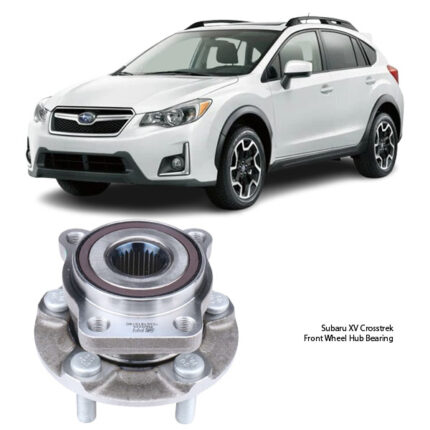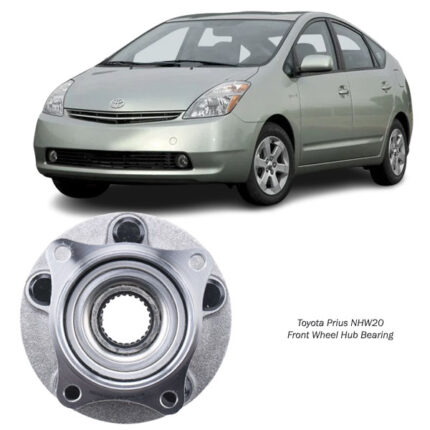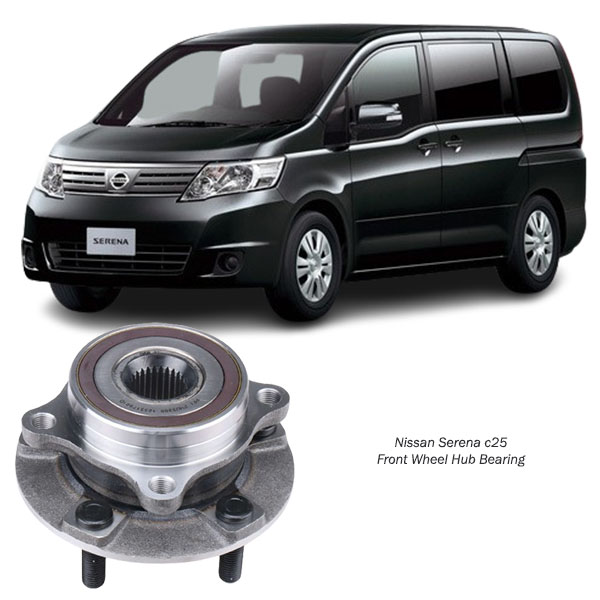-14%
Get Nissan Serena c25 Front Wheel Hub Bearing 40202-JG000 in Kenya
The front wheel hub bearing is a crucial component in a vehicle’s suspension and drivetrain system. It plays a vital role in ensuring smooth wheel rotation, reducing friction, and supporting the vehicle’s weight while driving. Despite being a relatively small part, it is essential for a car’s safety, handling, and overall performance. In this detailed guide, we will explore the function, structure, benefits, symptoms of failure, and maintenance of front wheel hub bearings.
1. What is a Front Wheel Hub Bearing?
A front wheel hub bearing is a pre-assembled unit consisting of precision-engineered bearings, a hub, and a flange. It allows the wheels to rotate freely while supporting the weight of the vehicle and reducing friction. The hub bearing is located at the center of the wheel assembly, inside the wheel hub, and is connected to the axle or drive shaft in front-wheel-drive vehicles.
Modern vehicles often use sealed hub bearings, which are pre-lubricated and require no regular maintenance. Unlike traditional bearings, which needed periodic lubrication, these sealed bearings provide longer service life and better protection against contaminants.
2. Functions of a Front Wheel Hub Bearing
The front wheel hub bearing serves several critical functions, including:
a. Enables Smooth Wheel Rotation
The primary function of a wheel hub bearing is to allow the wheels to spin smoothly with minimal friction. The bearing contains steel balls or rollers that roll against an inner and outer ring, reducing resistance and ensuring free movement.
b. Supports Vehicle Load
Wheel hub bearings are designed to bear the entire weight of the vehicle while driving. They distribute the load evenly, ensuring stability and reducing stress on other suspension components.
c. Reduces Friction
Friction between moving parts generates heat and can cause premature wear. Hub bearings are lubricated with grease, which minimizes friction, prevents overheating, and extends their lifespan.
d. Enhances Steering and Handling
A properly functioning wheel hub bearing maintains wheel alignment and stability, which improves steering response and handling precision. Faulty bearings can cause loose steering or vibrations, making the vehicle unsafe to drive.
e. Supports ABS and Traction Control Systems
Modern hub assemblies integrate wheel speed sensors that communicate with the Anti-lock Braking System (ABS) and Traction Control System (TCS). This helps prevent wheel lock-up during braking and enhances stability on slippery roads.
3. Types of Front Wheel Hub Bearings
There are different types of hub bearings used in vehicles, including:
a. Ball Bearings
Ball bearings are the most common type, using small steel balls inside a metal ring. They reduce rolling friction and provide smooth wheel movement.
b. Roller Bearings
These use cylindrical rollers instead of balls, providing a larger contact area and better load-bearing capacity. They are ideal for heavy-duty applications.
c. Tapered Roller Bearings
These bearings are commonly found in trucks and SUVs, as they handle both radial and axial loads efficiently. The tapered design ensures even weight distribution.
d. Sealed Hub Bearings
Most modern vehicles use sealed bearings that come pre-lubricated and enclosed, preventing contamination and eliminating the need for maintenance.
4. Benefits of a Good Front Wheel Hub Bearing
Investing in high-quality hub bearings offers several advantages:
✅ Improved Safety – A reliable bearing ensures stability and prevents wheel detachment.
✅ Better Handling – Smooth wheel rotation enhances driving comfort and precision.
✅ Reduced Noise and Vibrations – A good bearing minimizes road noise and unwanted vibrations.
✅ Enhanced Fuel Efficiency – Low friction means less resistance, leading to better fuel economy.
✅ Longevity of Other Components – Healthy bearings reduce stress on the suspension, brakes, and tires.
5. Symptoms of a Failing Front Wheel Hub Bearing
Recognizing the signs of a worn-out wheel hub bearing can help prevent accidents and costly repairs. Here are some common symptoms:
a. Unusual Noises
A grinding, humming, or roaring noise from the wheel area is a common indicator of a bad bearing. The noise typically gets louder as speed increases.
b. Wheel Play or Looseness
If the wheel wobbles or has excessive movement when shaken, it could be due to a failing hub bearing.
c. Vibrations in the Steering Wheel
A worn-out bearing can cause vibrations that are felt in the steering wheel, especially at high speeds.
d. Uneven Tire Wear
A failing bearing can cause misalignment, leading to irregular tire wear and reduced tire lifespan.
e. ABS Malfunction
Since modern hub bearings contain ABS sensors, a faulty bearing may trigger the ABS warning light on the dashboard.
f. Pulling to One Side
If the vehicle drifts to one side while driving, it could be due to a damaged bearing affecting wheel alignment.
6. Causes of Wheel Hub Bearing Failure
Several factors can contribute to the premature failure of hub bearings:
🔧 Lack of Lubrication – Bearings that lose lubrication due to seal damage wear out quickly.
🔧 Contamination – Dirt, water, and debris can enter the bearing and cause wear.
🔧 Excessive Load – Overloading a vehicle puts extra stress on the bearings.
🔧 Impact Damage – Hitting potholes, curbs, or speed bumps at high speed can damage the bearing.
🔧 Improper Installation – Using the wrong torque settings during installation can lead to early failure.
7. Maintenance Tips for Front Wheel Hub Bearings
To extend the life of your wheel hub bearings, follow these maintenance tips:
✔️ Regular Inspections – Check for signs of wear, noise, or movement in the wheel assembly.
✔️ Avoid Water Exposure – Driving through deep water can lead to contamination inside the bearing.
✔️ Proper Wheel Alignment – Misaligned wheels put extra stress on the bearings.
✔️ Timely Replacement – If a bearing is worn, replace it immediately to prevent further damage.
✔️ Use Quality Parts – Always choose OEM (Original Equipment Manufacturer) or high-quality aftermarket hub bearings.
8. Replacing a Front Wheel Hub Bearing
Replacing a front wheel hub bearing requires mechanical expertise and special tools. The process involves:
1️⃣ Lifting the vehicle and removing the wheel.
2️⃣ Unbolting the brake caliper and rotor.
3️⃣ Removing the old hub assembly.
4️⃣ Installing the new hub bearing assembly.
5️⃣ Reassembling all components and torquing bolts to manufacturer specifications.
If you’re unsure, it’s best to have a professional mechanic handle the replacement.
Conclusion
The front wheel hub bearing is a small but essential part of a vehicle’s suspension system. It ensures smooth wheel rotation, supports the vehicle’s weight, and enhances driving stability. A failing bearing can cause noise, vibrations, and handling issues, making early detection and maintenance crucial. By using high-quality bearings, avoiding harsh driving conditions, and ensuring proper installation, you can extend the lifespan of your wheel hub bearings and enjoy a safer driving experience.
Follow us on Facebook for more parts.



